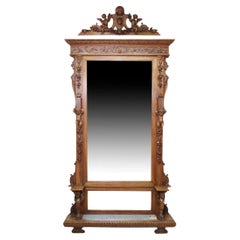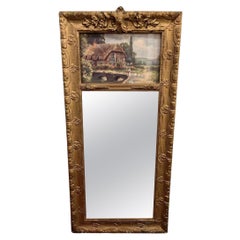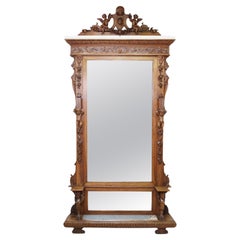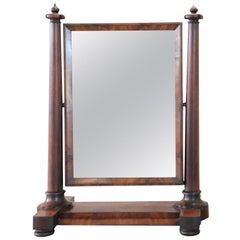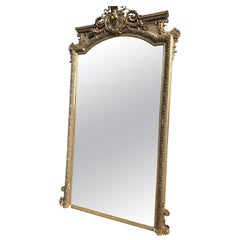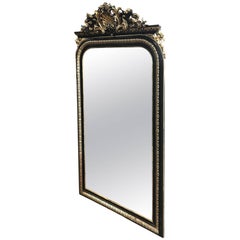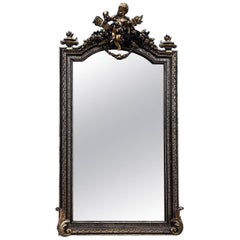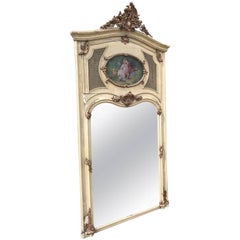1800s Antique Mirrors
Antique 19th Century Italian Renaissance Revival Floor Mirrors and Full-...
Mirror, Wood
Antique Early 1800s Trumeau Mirrors
Wood
Antique 19th Century Italian Renaissance Revival Floor Mirrors and Full-...
Mirror, Wood
Antique 1880s French Louis XVI Mantel Mirrors and Fireplace Mirrors
Gold Leaf
Antique Early 1800s Italian Empire Table Mirrors
Mahogany
Antique 19th Century French Wall Mirrors
Antique 19th Century French Wall Mirrors
Antique 19th Century French Wall Mirrors
Antique 19th Century French Wall Mirrors
Antique Late 19th Century Italian Louis XV Wall Mirrors
Giltwood
Antique 19th Century French Wall Mirrors
Antique 1790s British George III Mantel Mirrors and Fireplace Mirrors
Giltwood
Antique Mid-19th Century European Desks and Writing Tables
Brass
Antique 19th Century French Louis Philippe Wall Mirrors
Mirror, Wood
Antique Late 19th Century Finnish Wall Mirrors
Mirror, Wood
Antique 1880s French Louis Philippe Wall Mirrors
Antique 19th Century French Mantel Mirrors and Fireplace Mirrors
Wood
Antique 19th Century French Louis XVI Wall Mirrors
Antique Late 19th Century French Louis Philippe Wall Mirrors
Antique 1890s French Country Wall Mirrors
Iron
Antique 19th Century French Louis Philippe Wall Mirrors
Antique 1810s Italian Neoclassical Wall Mirrors
Walnut
Antique Late 19th Century French Wall Mirrors
Antique 19th Century European Empire Pier Mirrors and Console Mirrors
Mirror, Wood
Antique Early 19th Century Swedish Gustavian Floor Mirrors and Full-Leng...
Glass, Wood, Paint
Antique Early 1800s Italian Empire Table Mirrors
Walnut
Antique 19th Century English Victorian Wall Mirrors
Wood, Oak
Antique 19th Century Italian Renaissance Revival Sideboards
Wood
Antique 19th Century Italian Renaissance Revival Coat Racks and Stands
Walnut
Antique 19th Century French French Provincial Wardrobes and Armoires
Wood
Antique 19th Century French Other Wardrobes and Armoires
Mirror, Wood
Antique 1890s American American Classical Fireplaces and Mantels
Mirror, Oak
Antique Late 19th Century English Barware
Crystal, Metal
Antique 1890s French Victorian Wall Mirrors
Brass
Antique Late 19th Century Louis Philippe Wall Mirrors
Glass, Wood
Antique 1860s French Wall Mirrors
Wood, Paint, Mirror
Antique Early 19th Century French Baroque Floor Mirrors and Full-Length ...
Wood
Antique 19th Century Italian Empire Floor Mirrors and Full-Length Mirrors
Cut Glass, Mercury Glass, Hardwood
Antique 1850s Danish Folk Art Wall Mirrors
Wood
Antique 1890s Swedish Country Wall Mirrors
Glass, Mirror, Wood
Antique Late 19th Century French Louis Philippe Mantel Mirrors and Firep...
Mirror, Wood
Antique Early 19th Century Italian Mantel Mirrors and Fireplace Mirrors
Wood
Antique 19th Century French Louis XV Wardrobes and Armoires
Mirror, Wood
Antique Late 18th Century Wall Lights and Sconces
Brass
Antique 19th Century European Gothic Revival Jewelry Boxes
Brass, Bronze
Antique 19th Century French Louis Philippe Wall Mirrors
Antique Early 19th Century French Empire Wall Mirrors
Mirror, Stucco, Wood
Antique Mid-19th Century French Louis Philippe Wall Mirrors
Mirror, Walnut
Antique Late 19th Century British Queen Anne Wall Mirrors
Mirror, Walnut
Antique 1820s British Empire Pier Mirrors and Console Mirrors
Giltwood
Antique Early 19th Century French Empire Wall Mirrors
Mirror, Stucco, Wood
1800s Antique Mirrors For Sale on 1stDibs
How Much are 1800s Antique Mirrors?
- 1stDibs ExpertMarch 22, 2022In the 1800s, miniatures were small portraits. People commissioned them to give as gifts to their loved ones to carry with them. In this way, miniatures were similar to modern wallet photographs. On 1stDibs, find a range of miniature portraits.
- Were there safes in the 1800s?1 Answer1stDibs ExpertMarch 31, 2023Yes, there were safes in the 1800s. Historical records indicate that by 1820, some companies used safes to protect goods from fire. Following market campaigns in the 1840s, more companies and individuals began to purchase safes as an anti-theft measure. Shop a variety of safes on 1stDibs.
- 1stDibs ExpertNovember 4, 2024To identify 1800s furniture, first check to see if your piece bears any maker's marks. Should you locate any, researching them using trusted online resources can help you determine the maker and age of your furniture. To determine if unmarked pieces date back to the 19th century, look for tool marks and variations in their carvings and ornamentation. Since 19th-century furniture was handmade, you should expect to find these signs of hand craftsmanship. A piece that shows no marks or inconsistencies in details is likely a contemporary machine-made reproduction. Familiarizing yourself with the characteristics of Rococo, Chippendale, Gothic Revival, neoclassical and other 19th-century styles can also be helpful. If you struggle to make an identification, consider consulting a certified appraiser or knowledgeable antique dealer. On 1stDibs, find a range of 19th-century furniture.
- 1stDibs ExpertFebruary 13, 2023In the 1800s, safes were usually made of metal like tin plating or sheet iron. Fireproofing the safes proved difficult, and during the 1820s, specific mixtures of materials such as mica, potash lye and alum were used to line a safe’s interior in order to prevent its contents from succumbing to fire damage. Shop a collection of safes on 1stDibs.
- 1stDibs ExpertNovember 2, 2023During the 1800s, necklaces, earrings, brooches and hair accessories were popular jewelry pieces in styles ranging from Georgian with enamel details to Victorian with floral flourishes. The commonly used gemstones of the 19th century included diamonds, emeralds, rubies, sapphires, garnets and amethysts. Gold was the dominant metal for jewelry, but silver became sought-after during the 1880s and 1890s. Explore an assortment of antique jewelry on 1stDibs.
- 1stDibs ExpertJune 30, 2023In the 1800s, nightstands were often called commodes. Prior to the advent of indoor plumbing, early nightstands contained a porcelain chamber pot in a cabinet that provided a convenient and private alternative to visiting the outhouse. Today, antique, new and vintage nightstands, which are pieces of bedroom furniture that are often called bedside tables, are typically low-profile tables that are positioned alongside one’s bed or elsewhere in a bedroom. Shop a selection of nightstands on 1stDibs.
- 1stDibs ExpertApril 5, 2022Yes, pocket watches peaked in popularity in the 1800s. The first pocket watch was created in Germany in 1510, but was originally too large for a pocket. In the 1600s, the design began to get more compact, but for a long time pocket watches were a rarity and a symbol of wealth. Shop an array of antique pocket watches on 1stDibs.
- What is 1800s art called?1 Answer1stDibs ExpertNovember 26, 2024What 1800s art is called depends on its age and style, as the century saw multiple movements. Most art historians refer to art that broke from traditional norms, produced in the 1860s and later, as modern art, and everything that preceded it as pre-modern art. Some of the art styles that were popular during the 19th century include Impressionism, Realism, Romanticism, Neoclassicism, Expressionism and Fauvism. Shop a wide range of 19th-century art on 1stDibs.
- 1stDibs ExpertDecember 4, 2023What wedding rings looked like in the 1800s was similar to other Victorian jewelry. The Victorian era spanned from 1837 to 1901, coinciding with the reign of Queen Victoria in the United Kingdom. At the beginning of this period, rings were made of gold and affordable only to the wealthy. Designs for Victorian-era rings often featured repoussé work and chasing, in which patterns are hammered into the metal. Some featured stones secured by collets, settings similar to bezels, with prongs and a closed back. On 1stDibs, find a selection of Victorian wedding rings.
- 1stDibs ExpertApril 5, 2022To tell if a mirror is antique, check the glass to see if it's wavy or has any imperfections. Modern glass tends to be perfect. While this can be a clue, it might just signify that the mirror is old, not antique. Another thing to check for is the reflective coating on the back of the glass to see if it has begun oxidizing and has any age scratches. Finally, check out the frame to see if it has the appearance of age. Shop a large collection of antique mirrors from some of the world’s top sellers on 1stDibs.
- 1stDibs ExpertApril 5, 2022An antique mirror is a mirror of considerable age that has historical significance or is in great demand due to its beauty or rarity. Oftentimes, you’ll hear an antique be defined as any item that is more than 100 years old, but this is not a specific measurement of an antique nor is it a requirement. Shop a collection of antique mirrors from some of the world’s top sellers on 1stDibs.
- 1stDibs ExpertFebruary 22, 2021You can tell if a mirror is antique through a number of indicators. For example, most antique mirrors are quite small in size, measuring no more than 2 feet. Additionally, antique mirrors will show signs of sports or discoloration. Many antique mirrors will have bubbling or waves in the glass.
- 1stDibs ExpertOctober 21, 2020
Repairs and replacements can go toward devaluing any piece of antique or vintage furniture, and any modifications or repairs done to a centuries-old mirror should be handled by experts and executed with care. Because antique Venetian mirrors were handcrafted by Italian artisans and can in some cases be hundreds of years old, it is strongly recommended that you consult with experts in the field of restoring antique or decorative mirrors in the event that your piece should require restorative work.
- 1stDibs ExpertJanuary 10, 2025The artist George Catlin's paintings from the 1800s are considered a form of artistic documentation because he depicted what he saw during his travels across North America. Catlin produced many images of Native Americans living their daily lives. In so doing, he provided a glimpse of what life was like for Indigenous people before the rapid westward expansion of settlers forcibly disrupted their traditions and culture. On 1stDibs, shop a variety of George Catlin art.
